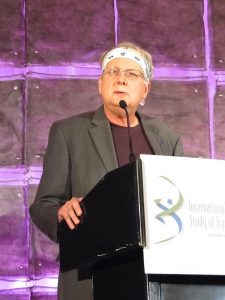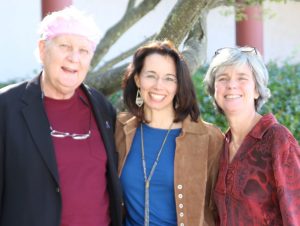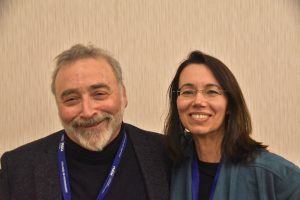An Interview between Warwick Middleton, MD and Frank Putnam, MD
Part Two: Reflections on The Society, Research and the Future
WM: What is your perspective of the early years of the Society? You are a particularly notable contributor here because, not long after the Society formed, you took a stand on the issue of recovered memories, particularly as they pertain to alleged satanic ritual abuse … warning people not to go beyond the verifiable data in making generalised statements. I guess that you again found yourself in the cross hairs of a polarisation.
FP: At the beginning, I believed that these were credible reports. I was swayed by supposedly hearing the same things from everybody.

Frank Putnam – ISSTD Annual Conference, Baltimore, 18th November 2013
I was joined by an anthropologist, Dr. Sherrill Mulhern. She studied dissociation as it was manifested in religions like Voodoo and in African ritual ceremonies. She had been studying Pentecostal churches and speaking in tongues. She asked if she could observe me. I said, “Yes.” I have always been open. Of course, this was long before medical privacy concerns … Sherrill shadowed me for about a month and we spent time talking about dissociative phenomena. She asked me questions about satanic ritual abuse that I couldn’t answer because the data weren’t there. Mulhern followed a half dozen major SRA presenters from conference to conference documenting how they increasingly aligned their stories often borrowing details from each other. So, of course, they all told the “same” stories.
As a result, I began to look more critically at the data put forth to support satanic ritual abuse stories. At the time a relatively few people were describing huge satanic masses in which scores to hundreds of children were sexually abused and murdered. I have been involved in the investigation of at least a hundred abuse-related child deaths – I never kept count. There is always some form of physical evidence. Hundreds of children don’t disappear without a trace. Law enforcement at numerous level from local police to the FBI investigated and found absolutely no evidence that these orgies were happening. Importantly, given the huge numbers of alleged victims, no bodies were ever found. That ultimately led me to conclude that this was an unfortunate rumour process sweeping the field.
At MPD meetings … there were heated arguments. I was accused of disrespecting victims. It culminated in a plenary session at a 1990 Society meeting in Chicago. I organized a plenary session in which presenters offered alternative explanations of the satanic ritual abuse allegations. It led to quite a shouting match…Anyone who expressed incredulity about these allegations was branded as part of the SRA conspiracy. I was called a Satanist many times.
It is a mistake to conflate reported use of religious symbols or rituals by an abuser as evidence that there are large SRA cults carrying on massive child sexual murders. I wrote a paper on this issue in 1991 on SRA, published in Child Abuse & Neglect (Putnam, FW 1991).
WM: What is your perspective on the subsequent history of that debate?
FP: I spent more than a decade doing child abuse forensic evaluations at Cincinnati Children’s Hospital. Thousands and thousands of child abuse cases came to our centre and I never saw one that had any credible satanic components. I did see what we would call “clergy abuse” now. So, there is clearly that sort of institutional abuse going on which we are learning more about … there are religious groups responsible for systematic sexual abuse of kids, but there’s been no credible evidence for a mass of satanic worshippers abusing and murdering children.
WM: Can you tell us about your relationship with ISSTD? I guess that in taking stands on key issues, that led you to take a bit of a parallel, or different path?
FP Yes, I think I felt alienated after the Society conference I referenced, where I moderated the alternative satanic ritual abuse plenary. I got a lot of grief. Some of it very

Frank Putnam, Bethany Brand and Karen Putnam, ISSTD Baltimore Regional Conference, 2017
inappropriate – intended to be physically intimidating.
I felt alienated, but at the same time I was also feeling the tug of child abuse, which is its own world. I was identifying more with that area. I saw dissociation as a very serious outcome of child abuse, but only one of many bad outcomes. I was shifting my limited time and ability to attend meetings and participate in working groups to other professional societies. … We continued to measure dissociation in our studies and to publish and collaborate on dissociation-related projects. But I really moved much more into the paediatric child abuse world. When I was at Cincinnati, I was a professor of paediatrics and directed child abuse clinical, forensic and trauma treatment training centres in the children’s hospital.
WM: I’m wondering from your perspective now, where do you see the Society going and what’s your impression of how it has evolved over time?
FP: Well, I have to say, I haven’t been to a meeting for a while but the last time I went back I was thinking – it’s still very much clinically-orientated, single case-orientated. It hasn’t moved along in some ways, the ways I had hoped. I think, on the other hand, it provides a refuge and a place to talk about difficult cases. That is a very important role. But it hasn’t advanced the science as much as I had hoped.
Ironically, I think the saving grace is the adoption of this new PTSD dissociative sub-type diagnosis in the DSM-5. It suddenly makes dissociation important to an influential group of people. They are finding out that dissociation predicts treatment refractoriness to a number of conventional therapies that work for PTSD. I think in a way that will ultimately bring more attention to dissociation.
It would be important for the Society to get out in front and lead on this issue, to develop PTSD dissociative sub-type expertise under the umbrella of the Society. It is something the Society should seek to take leadership of. This is the chance to say OK we got PTSD, and we’ve got PTSD dissociative sub-type. What are the differences? What are the important roles of that dissociation plays here? However, I think that to some people this will still be as threatening as DID.
WM: How threatening is that, Frank, still in 2019?
FP: I think DID remains quite threatening to many people – this idea that people could have multiple personalities and switch back and forth. … I think unfortunately the media has created a stereotype, often a violent stereotype. So that’s part of what is frightening to people.
Also, there are a lot of people who just simply can’t believe it. How could this be!? It doesn’t make sense to them, and they miss it, even when it’s right in front of them. I certainly have seen DID patients switching away and the interviewer having no idea that this is going on or asks a vaguely-perceptive question like, “Did you just hear an hallucination?” Something like that. They recognise that something changed in the patient but they attribute it to more “conventional” symptoms like hallucinations.
WM: Frank, one of the underlying parts of your research from early on has been an interest in states of consciousness. Can you run us through how that interest developed and your work in defining such states?
FP Well as I mentioned, I was first working with traumatised individuals and saw abreactions, flashbacks – those sorts of powerful experiences. On the NIH rapid cycling bipolar research unit, I saw many, many switches between mania and depression, frequent anxiety attacks, cases of catatonia. In each case these were pathological states that seized control of the person’s mental and physical behaviour. I really began to see that there were similarities across these states … a property that I would call “stateness” to all of them, even though the states themselves were quite different.
I began to ask the question, “What are the commonalities among different states of mind/being – including normal states like sleep which consists of a cyclic series of discretely different states – Stages I-IV and REM?
Working with infants, I became interested in infant states and discovered there was a whole literature on infant states. The idea is that – in a healthy newborn – we come into this world already organised with a series of discrete behavioral states – typically about five different states that the infant recurrently cycles through. These discrete behavioral states underlie the well-recognised sleep-wake-fussy-feeding-quiet alert-drowsy-sleep-wake-etc. cyclic behaviour of a newborn infant.
When you began to look at collections of different mental/physical states you realise how they all share a set of common properties. They tend to occur in cycles that are predictable, the transitions are generally short, and marked by changes in affect, facial expression, alertness, cognition, memory, changes in posture and muscle tone, brain activity patterns and other kinds of changes. They often have a rapid onset and a slower offset, there are differences in what people remember about a given state. Most people don’t realise they have switched states until later.
I became interested in the idea that states are a basic unit of behaviour, a fundamental unit of consciousness that explain a lot of things that were here-to-fore inexplicable in traditional psychological theories. That is the essence of my last book, The Way We Are: How States of Mind Influence Identities, Personality, and Potential for Change (Putnam, FW 2016).
The Way We Are looks at numerous examples of different types of states and switches to extract the commonalities. The book outlines a state-based theory of the development and expression of “personality”.
WM: One of the things you actually said in that book was, if you had 5 minutes to tell someone the most important things to know about you, and the course of your life, what would you say? You were pointing out that depending on the time or the day or the date you may say different things. If I was to pose that same question back to you right now, what would you say today – the 19th February 2019?
FP: Well, I would say that I am satisfied with the journey that I went on. I followed whatever was interesting to me. I feel like I have come up with some answers, at least for myself, in terms of understanding these things. I’ve made certain kinds of contributions. Eventually people will pay more attention to the state model. I believe that it is important to be looking at states and understanding human psychology from a state point of view.
I’m at peace with having a terminal illness and I’m trying to get the max out of it. I’m still publishing papers. I continue to work in the child abuse area, working on the effects of different of combinations of maltreatment – trying to identify synergistic combinations of ACEs that are especially pernicious. We could use this knowledge to identity people who are at higher risk – particularly still asymptomatic young children who are at much higher risk. Then we would target them for special prevention activities.

Frank’s long term collaborators Rich Lowenstein & Bethany Brand, ISSTD Annual Conference, New York, 2019
WM: You mentioned publishing papers and that brings up your collaborations with Bethany Brand and Rich Lowenstein and others. Would you like to comment on that line of research that you and your colleagues have been involved in?
FP: Richard Lowenstein and I have been friends since residency. We were co-residents at Yale. At the NIH, I discovered two cases of MPD and Richard identified a third case. That made the first paper we wrote about MPD/DID – these three cases. We worked together and have stayed in the loop over our careers.
Bethany started out as a research assistant on the longitudinal research project that Penny Trickett and I were doing. She was one of our first research assistants. She got a master’s degree with us. Then she went off and got a PhD in Psychology and did her internship on Richard’s Dissociative Disorders Unit at Sheppard Pratt Hospital.
Bethany is a real go-getter! She gets things done. I love to let her bounce ideas off me. We sort of plan something theoretically and then she goes out and makes it happen. She is very effective, very creative – especially given the limitations on resources in the DID research field. I feel that Bethany has really advanced the research – especially on treatment – in many, many ways. She has also been a great mentor to many students.
WM: Where do you see the field in ten years’ time? You’ve laid out some challenges for us.
FP: Again, I really feel like the field needs to take advantage of the DSM-5 diagnosis of PTSD Dissociative sub-type – even though I’m not terribly happy with the criteria. It doesn’t look at the amnesia component as much as I think it should. Nonetheless, I think that diagnosis is an important foot in the door that will help to normalise the dissociative disorders for people who right now can only see them, at best, as very weird or strange.
In 10 years, we should have some pretty good interventions for dissociation. We should be identifying more dissociative children … be looking for early pathological dissociation in children and adolescents. I think pathological dissociation is probably the most treatable in young children. We must do that kind of early intervention/prevention work. The earlier that we can identify victims, the more prevention of future trauma and dissociation that we can do. The more we can save people from painful, dysfunctional lives.
Right now, prevention programs are everywhere – but they are not coordinated. We must learn to consolidate these, especially the ones that address a shared risk factor such as maltreatment. I think that the prevention of child maltreatment is importantly involved in the prevention of substance abuse, for example. … Childhood maltreatment is also a huge risk factor for domestic violence in adulthood – both as victim and perpetrator. There’s a relationship between childhood maltreatment and cardiac health.
If we could do better at integrating different prevention programs, especially focusing on the role of child maltreatment, we could dramatically increase the health of the general population. I tend to think about ACEs from a public health point of view.
WM: Are there particular issues or points that you would like to have your say on?
FP: My interests now are mostly in prevention and thinking about large scale ways to prevent child maltreatment. I feel there’s a lot that needs to be done.
I was very involved in the development of the National Child Traumatic Stress Network (NCTSN). The NCTSN is a network funded by the U.S. Congress – around $60 million a year. It has over a hundred centres across the U.S. that work with traumatised children. The centres collaborate. We have been able to get some large data sets. The NCTSN has developed or adapted many good, evidence-based treatments for children and families for a variety of types of trauma. The pressing question now is how to get these interventions out to the rest of the world in some organized and quality assured way.
References
Putnam, FW (1991) The Satanic Ritual Abuse Controversy, Child Abuse & Neglect, Vol 15, pp. 175-679. 1991
Putnam, FW (2016). The Way We Are: How States of Mind Influence our Identities, Personality and Potential for Change. IPBooks, New York.

